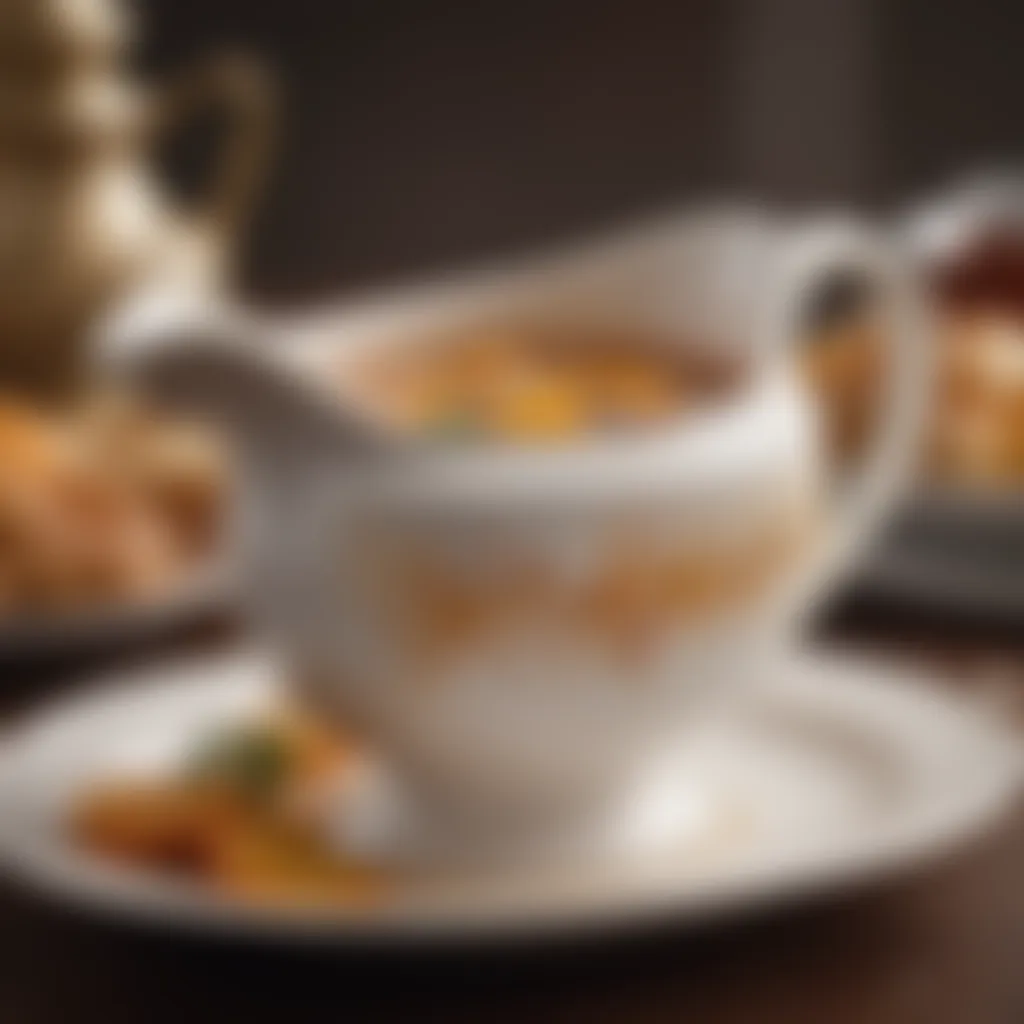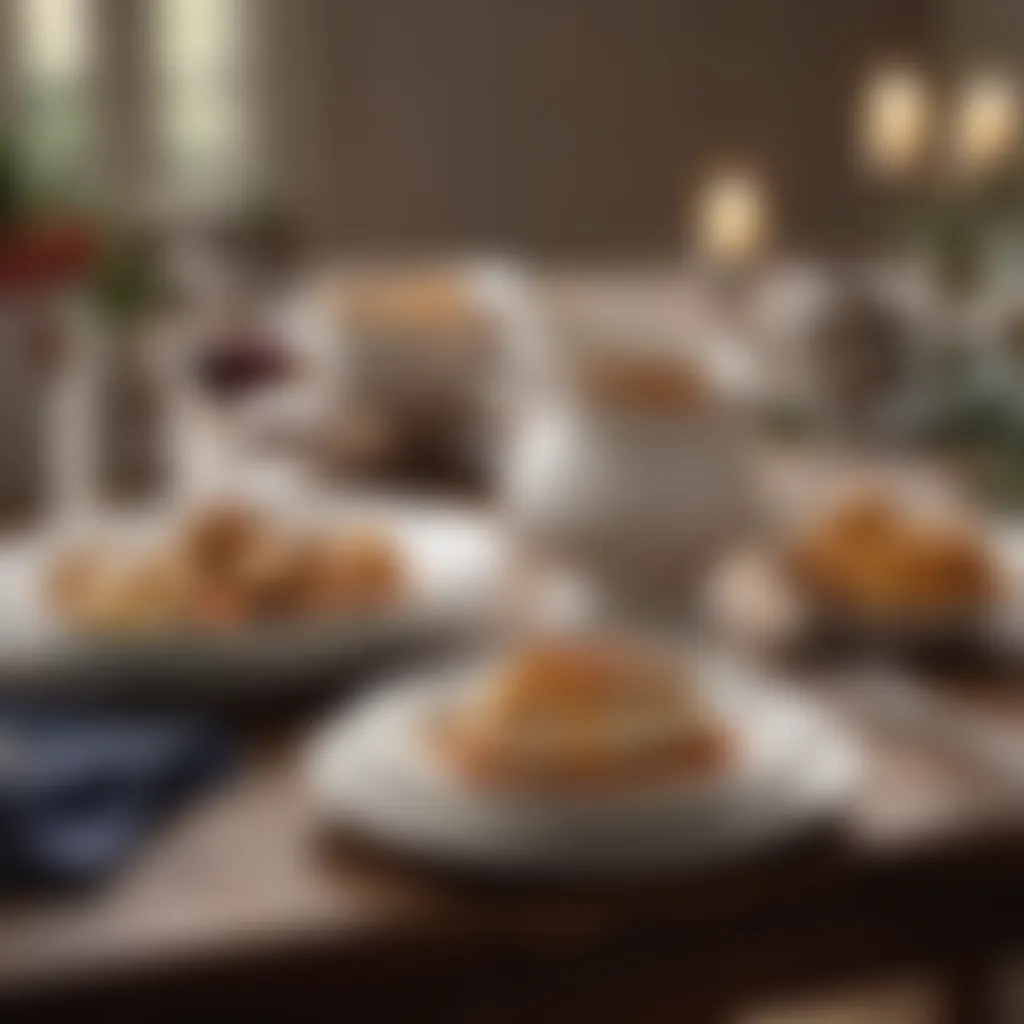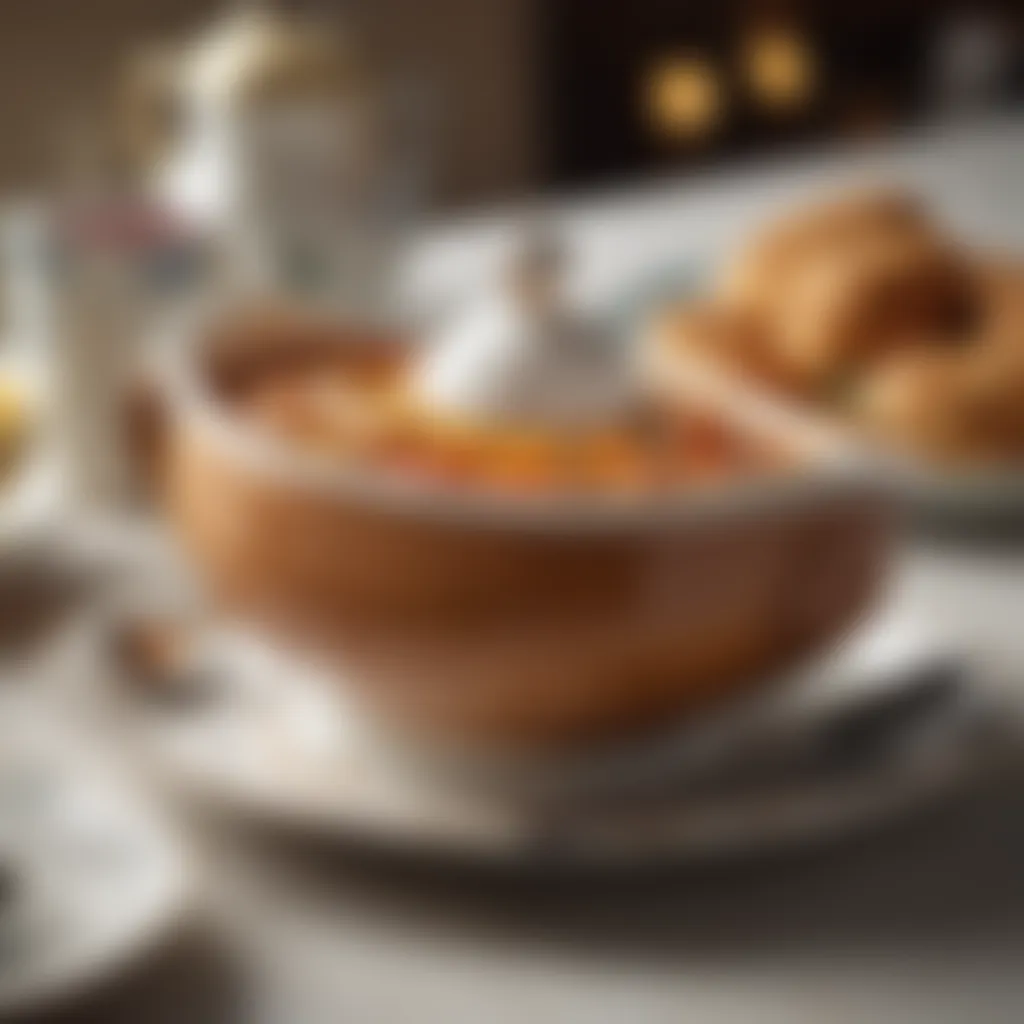The Art and Elegance of Warming Gravy Boats


Intro
The warming gravy boat serves an essential role in modern dining, extending far beyond mere functionality to symbolize a cultural appreciation for attention to detail in culinary presentation. As culinary enthusiasts and seasoned housewives pave the way in modern kitchens, understanding the subtle art of utilizing a warming gravy boat becomes paramount. The convergence of warm gravy, elegant design, and thoughtful etiquette elevates any meal.
A warming gravy boat not only ensures that savory sauces maintain their ideal temperatures, but also adds an element of sophistication to the dining table. Understanding how to effectively use this tool is crucial for anyone keen to deliver a memorable dining experience.
Ingredients:
When preparing a rich, flavorful gravy, the following ingredients are recommended to achieve a consistent texture and delectable taste:
- 4 tablespoons unsalted butter
- 1/4 cup all-purpose flour
- 2 cups chicken or beef broth
- 1 teaspoon salt (adjust to taste)
- 1/2 teaspoon ground black pepper
- 1 tablespoon fresh herbs (such as thyme or rosemary, chopped)
Preparation Steps:
- Melt the Butter: In a medium saucepan, melt the butter over medium heat. Make sure not to let it brown to avoid altering the flavor.
- Create a Roux: Once the butter is melted, add the flour. Stir continuously for about 2-3 minutes until the mixture forms a smooth paste and a light golden color.
- Add Broth Gradually: Slowly pour in the broth while whisking to combine fully. This ensures no lumps form in the gravy.
- Season the Mixture: Add salt, black pepper, and herbs, ensuring the seasonings are well-distributed.
- Simmer: Allow the gravy to simmer for approximately 10 minutes, stirring occasionally. This will help the gravy thicken and develop a richer flavor.
Technical Aspects:
Understanding temperature control is vital when using a warming gravy boat. Here are some key technical details:
- Warming Mechanism: The gravy boat may either be heated externally or internally. An external heat source keeps the gravy warm through a well or a base filled with hot water.
- Temperature Setting: The ideal temperature for serving gravy is between 140°F to 160°F.
- Timing Specifics: Typically, gravy should be served freshly made, but it can retain warmth for about 1 hour in a well-insulated gravy boat.
Cooking Process:
- Pour the prepared gravy into the warming gravy boat immediately after cooking.
- If using an external heat source, place the gravy boat above the simmering or heated water. Make sure the base of the boat does not touch the water directly to prevent overheating.
- If the gravy thickens when left on heat, whisk in small amounts of broth or water gradually until the desired consistency is reached.
Troubleshooting Tips:
- Too Thick: If your gravy is too thick, whisk in a small amount of hot broth or water until the desired texture is achieved.
- Too Thin: For thinner gravy, a cornstarch slurry might work, mixing 1 tablespoon cornstarch with 2 tablespoons cold water before stirring into the gravy.
- Seasoning: Always taste and adjust the seasoning before serving, as flavor profiles can change during the cooking process.
"A well-prepared gravy elevates not only the meal but also the entire dining experience."
Intro to the Warming Gravy Boat
The warming gravy boat is more than just a serving dish; it plays an essential role in modern dining, particularly when it comes to enhancing the overall meal experience. Its primary function is to keep gravy or sauces at an optimal temperature, ensuring that these accompaniments remain warm from the kitchen to the dining table. This aspect is crucial because serving cold gravy can detract from the flavors of the meal, leading to a less satisfying dining experience.
In this section, we will examine the various elements that contribute to the importance of the warming gravy boat. Understanding its purpose not only enriches the dining experience but also informs its appropriate use. The elegance and functionality of a well-designed gravy boat can impress guests and elevate a simple meal into something special.
This article addresses various benefits associated with the warming gravy boat, such as its design, ease of use, and the positive impressions it can create. Properly utilizing this tool allows for seamless meal presentation. Furthermore, knowing its historical context adds depth to our understanding of this culinary item.
"The warming gravy boat serves as a bridge between tradition and modern dining practice, reflecting our evolving culinary tastes while honoring time-honored customs."
As we proceed, let's delve into the definition of the warming gravy boat and its historical significance.
Design Considerations
In the realm of culinary presentation, the warming gravy boat serves not only as a vessel for sauce but as an integral piece of tableware. To maximize its utility, several design considerations come into play. First, functionality takes precedence; a well-designed gravy boat maintains the temperature of its contents while allowing ease of serving. Secondly, the aesthetic appeal of the gravy boat complements the overall dining experience. How the gravy boat looks can enhance the atmosphere of a meal and influence guests’ perceptions of the food. Therefore, choosing a gravy boat involves balancing form and function.


Functional Aesthetics
The concept of functional aesthetics focuses on designs that are both pleasing to the eye and highly practical. A well-crafted warming gravy boat should embody this principle. Many gravy boats incorporate ergonomic shapes that facilitate easy pouring. The handle should be comfortable to hold, allowing for precise control when serving gravy or sauces. Moreover, features such as spouts that prevent drips and spills are essential. Aesthetically, the color, shapes, and finishes can enhance the dining setting. For instance, a polished stainless-steel gravy boat may convey modernity, while a ceramic one might evoke warmth and tradition.
Material Choices
The choice of material influences not just the look but functionality and durability of a warming gravy boat. Here, three popular materials are examined: Ceramic, Stainless Steel, and Glass.
Ceramic
Ceramic is a favored option for many due to its classic, timeless appeal. This material provides a certain warmth, making it suitable for homely settings. Key characteristics of ceramic include its ability to retain heat well. This property ensures that your gravy remains warm for a more extended period during serving. However, ceramics can be susceptible to chipping or breaking if not handled carefully. Their weight can also make them less convenient to pass at a large gathering.
Stainless Steel
Stainless steel is notable for its durability and modern aesthetic. This material is often a popular choice because it is resistant to tarnish, which means it can maintain its attractive finish with minimal effort. It provides excellent insulation, helping to keep gravies warm for long durations. Another aspect of stainless steel is its lightweight characteristic, making it easy to handle. However, one disadvantage is that it can conduct heat quickly, which may make the exterior too hot to touch if the gravy inside is heated excessively.
Glass
Glass offers a unique option that many find visually appealing. It allows the contents of the gravy boat to be seen, which can enhance presentation. This transparency can make the meal more inviting. Glass typically has a neutral flavor, ensuring that it does not interfere with the taste of the sauces served. However, glass can be fragile and prone to shattering if mishandled, which is a significant downside. It also lacks the heat retention properties of the other materials, making it less effective for keeping gravies warm for extended periods.
The choice of material can significantly affect both the practical use and aesthetic appeal of a warming gravy boat.
In summary, careful consideration of design elements such as functional aesthetics and material choices is critical when selecting a warming gravy boat. Each material comes with unique characteristics that affect performance and presentation in different ways. Proper understanding can enhance the dining experience significantly.
Mechanisms for Temperature Maintenance
The ability to maintain an appropriate temperature for gravy is crucial in ensuring the dish reaches the table warm and flavorful. The focus of this section is on the various mechanisms for temperature maintenance that can enhance dining experience. Each method presents distinct benefits and considerations, which can guide housewives in choosing the right solution for their culinary needs.
Electric vs. Non-Electric Options
Electric gravy boats offer a convenient way to keep gravy hot without the need for additional monitoring. They are equipped with heating elements that maintain the desired temperature consistently. This type of gravy boat is particularly useful during lengthy gatherings or holiday meals when dishes may take time to be served.
Conversely, non-electric options, such as traditional warming gravy boats, rely on external heat sources. These can include chemical warmers or placement over stovetops. While these methods might require more attention, they allow for greater flexibility in using different serving styles.
Choosing between electric and non-electric options depends on individual preferences and dining occasions. Consider:
- Ease of use
- Required space for storage
- Personal cooking style
- Frequency of use
Water Bath Method
The water bath method is a classic technique known for its effectiveness in preserving the warmth of the gravy. This method involves placing the gravy boat inside a larger vessel filled with hot water. The surrounding water creates a gentle and consistent heat that keeps the gravy warm without risking overcooking or burning.
Key advantages of the water bath method include:
- Steady heating without direct contact with flame or heat source
- Maintaining the integrity of the gravy’s flavor and texture
- Reducing the risk of scorching that may occur with other heating methods
Housewives might find this method particularly useful for providing a sophisticated touch at dinner parties and holiday meals. It is essential, however, to periodically check the water level to ensure consistent heating.
Chafing Dishes


Chafing dishes are widely recognized in the catering industry for their efficiency in keeping food warm. These dishes typically are constructed with a framework to hold the food container above a heat source, which could be alcohol burners or electric heating elements.
Using chafing dishes for gravy offers several benefits:
- Capacity: They generally accommodate larger quantities, making them ideal for buffets.
- Practicality: They can serve multiple dishes simultaneously, allowing a cohesive dining experience.
- Presentation: They are visually appealing and can enhance the overall aesthetic of a dining table.
In considering chafing dishes for personal use, housewives should evaluate space availability and the need for multiple food items to be served warm. Each mechanism for temperature maintenance has its place in culinary applications, and thoughtful selection can elevate any meal.
Cultural Significance
The warming gravy boat holds a special place in culinary culture. It is not merely a vessel for serving sauce. Instead, it embodies traditions, rituals, and values associated with dining and hospitality. Through their history, gravy boats have signified the importance of presentation and attentiveness when serving food. This section underscores how they enrich the dining experience and elevate gatherings.
Gravy Boats in Culinary Traditions
Gravy boats feature prominently in various culinary traditions around the world. They are often associated with grand meals and family gatherings. In European traditions, for example, they are commonly present during festive occasions such as Christmas, Thanksgiving, and Easter dinners, where rich sauces complement roast meats. Gravy boats allow for an elegant presentation while ensuring that the sauce remains warm throughout the meal. This enhances the overall sensory experience of the dish.
In Asian cuisines, sauce-serving vessels may vary but share a similar cultural role. They bring flavor-rich sauces to the table, allowing diners to customize each bite to their liking. These vessels are an integral part of the meal’s aesthetic, contributing not only to the decor but also to the flavors offered.
Key points of cultural significance in culinary traditions include:
- Elevation of family meals to ceremonial status.
- The importance of preserving food quality and temperature.
- Creation of a cohesive dining atmosphere that encourages interaction.
Symbolism in Social Gatherings
The warming gravy boat carries symbolism that extends beyond practical use. It represents hospitality, care, and attention to detail when hosting guests. The act of serving gravy from a beautifully designed boat can be seen as a gesture of warmth and affection toward visitors.
When people gather around the table, the food served acts as a social glue. The gravy boat, in its role, signifies a shared experience. It invites conversational exchange and fosters connections, enhancing friendships and family bonds.
Here are a few aspects of what a gravy boat represents:
- Hospitality: A beautifully arranged table with a warming gravy boat conveys welcome.
- Connection: Sharing sauce fosters conversations and interactions among guests.
- Care: Attention to serving detail indicates the host's commitment to providing a delightful dining experience.
"A meal without a proper sauce is like a gathering without conversation; both miss an essential quality that brings joy."
In modern dining, the gravy boat still maintains its cultural significance, bridging generations and traditions. Its historical roots appeal to the contemporary housewife, connecting her with family heritage while welcoming new culinary trends.
Modern Applications
The warming gravy boat serves not only a practical purpose but also plays a significant role in contemporary dining experiences. As society moves towards a more sophisticated understanding of gastronomy, the warming gravy boat remains relevant due to its design and functionality. Modern applications make this traditional tool adaptable to various settings, enhancing both home dining and professional catering.
Trends in Home Dining
In recent years, home dining trends have shifted toward creating restaurant-like experiences at home. Many households now prioritize aesthetics and functionality, seeking to replicate the dining ambiance found in high-end venues. The warming gravy boat fits seamlessly into this trend. It elevates the presentation of meals while keeping sauces warm, thereby ensuring an optimal dining experience.
The careful selection of materials, such as stainless steel or handcrafted ceramic, allows for personalization that complements home decor. Using a warming gravy boat during family gatherings or special occasions makes serving sauces more elegant. Home cooks understand that keeping gravy or sauces warm enhances the flavor profile and allows guests to indulge in meals at their leisure.
- Aesthetic Appeal: A warming gravy boat adds elegance to the dining table.
- Functional Use: It allows guests to serve themselves, promoting a relaxed atmosphere.
- Versatility: It can be used for various sauces, broths, or even melted chocolates, making it suitable for different meals.
Use in Professional Catering


In the realm of professional catering, the warming gravy boat is indispensable. Catering events, whether weddings, corporate functions, or private gatherings, demand a level of professionalism and attention to detail. Gravy boats that maintain temperature not only ensure food safety but also enhance the overall presentation of dishes.
Caterers often face challenges with maintaining the quality of their sauces. By utilizing warming gravy boats, they can provide guests with warm sauces without requiring additional heating elements. This makes serving more efficient and allows for better organization on buffet tables. Additionally, the choice of materials in professional settings often leans towards durability and ease of cleaning.
- Efficiency: Streamlined serving process during busy events.
- Quality Control: Maintaining temperature reduces the risk of spoilage.
- Brand Image: A well-presented dish contributes to the caterer's reputation.
Utilizing a warming gravy boat not only signifies sophistication but also ensures that the essence of culinary creations is retained from the kitchen to the dining table.
Etiquette and Best Practices
Understanding etiquette surrounding the use of a warming gravy boat is crucial for enhancing dining experiences. It elevates not only the meal presentation but also contributes to the overall ambiance of a gathering. Proper use of a gravy boat reflects attention to detail and respect for guests. In this section, we will explore specific serving techniques and common pitfalls that can improve your skillful use of this culinary tool, especially in a home setting.
Serving Techniques
Using a warming gravy boat requires a thoughtful approach to ensure an effective and elegant service. Here are several techniques to adopt:
- Preparation: Before serving, ensure that the gravy is adequately heated. Cold gravy can detract from the meal’s enjoyment. Depending on the method you choose, keep it at a consistent warm temperature.
- Positioning: Place the gravy boat at the center of the dining table. A central location makes it easily accessible for all guests. Ensure it is on a placemat or serving tray to prevent spills.
- Pouring: Hold the gravy boat at the handle, tilting it slightly to avoid drips. Pour slowly, allowing individuals to control the amount they desire. This prevents over-saturation of food, which can be unappealing.
- Offering Refills: When necessary, check in with your guests to see if they require more gravy. This shows attentiveness and enhances dining pleasure. If refilling, use a small ladle or a separate container to maintain cleanliness.
- After Use: Once the meal is complete, promptly remove the gravy boat from the table. Leaving it can make the setting look cluttered and distract from post-meal conversations.
Common Pitfalls
While using a warming gravy boat may seem straightforward, several common pitfalls can diminish its effectiveness:
- Overheating the Gravy: Excessive heat can cause the gravy to separate or lose flavor. It's essential to maintain a moderate temperature.
- Neglecting Cleanliness: Always ensure the gravy boat is clean before serving. Any residue can affect taste and presentation. Additionally, after each use, clean it thoroughly to maintain hygiene.
- Not Considering Guest Preferences: Some guests may not prefer gravy. Be mindful of dietary restrictions or preferences and offer alternatives, such as sauces or dressings.
- Ignoring the Aesthetic: Presentation matters. A tarnished or chipped gravy boat can create an unpleasant impression. Always use well-maintained tableware to enhance the dining experience.
"Using a warming gravy boat is not just about functionality; it is about creating a pleasant atmosphere for your guests."
Impact of Technology
The influence of technology on culinary tools is undeniable. In the case of warming gravy boats, innovation plays a significant role in enhancing user experience and maintaining food temperature. Modern advancements in materials and design fundamentally transform how these vessels function and are perceived in various dining contexts.
Innovations in Gravy Boat Design
Today’s warming gravy boats are not just functional. They are also aesthetically pleasing and efficient. New materials like high-tech ceramics reduce heat loss while providing an elegant appearance. Stainless steel models often include double-walled designs, which help insulate heat better than traditional one-walled boats.
Efforts in ergonomic design make handles easier to grip, minimizing spills when serving. Integrated lids have also become more prevalent, allowing for better heat retention and preventing contaminants from entering the gravy. Such innovations ensure the warm gravy is tasty and served at an optimal temperature, benefiting both the host and guests.
Smart Gravy Boats
Smart technology is also entering the realm of gravy boats. These smart gravy boats come equipped with temperature sensors that notify you via smartphone when the gravy is at the perfect serving temperature. Some models are even designed with heating elements activated by simple controls, providing immediate warmth when needed.
The emergence of smart technology addresses common issues like forgotten vessels left on a stove. It allows for precise temperature management, which results in maintaining the flavor and texture of the gravy.
"It’s not just about keeping the gravy warm; it’s about elevating the entire dining experience."
Epilogue
The conclusion of this article sheds light on the vital role that a warming gravy boat plays in modern dining experiences. This culinary tool is more than just a serving piece; it represents tradition, hospitality, and attention to detail. As we explored throughout the article, a warming gravy boat enhances the dining table not only by keeping sauces and gravies at an optimal temperature, but also by contributing to the overall presentation of the meal.
Recap of Importance
In summary, the warming gravy boat stands out as an essential kitchen accessory for several reasons. It ensures that the flavors of gravies and sauces remain intact and enjoyable from the start of the meal to the last bite. When guests can enjoy perfectly warmed sauces, it elevates their overall dining experience. This type of vessel also embodies cultural heritage, serving as a reminder of gatherings and the importance of food in social interactions. From formal dinners to casual family meals, the warming gravy boat is a symbol of culinary care.
Future of the Warming Gravy Boat
Looking ahead, we can anticipate that the warming gravy boat will continue to adapt to contemporary dining trends. The integration of technology in kitchenware may lead to innovative designs, such as smart gravy boats equipped with temperature sensors, capable of maintaining ideal serving conditions more effectively. As more households embrace gourmet cooking styles and a heightened focus on presentation, usage of warming gravy boats is likely to become more prevalent. They may evolve further, both in materials and functionalities, while retaining their core purpose of enhancing the dining experience.







